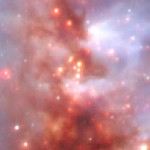Science & Environment
Boston University Study Images Magnetic Field in a Young Star for the First Time

 (Boston) — Ian Stephens, a postdoctoral associate for Boston University’s Institute for Astrophysical Research, along with a collaboration of people at the University of Illinois and throughout the world, imaged the magnetic field around the disk of a young star for the first time. The findings of his research, which was published in Nature magazine, gives a better understanding of the role of magnetic fields for the formation of stars.
(Boston) — Ian Stephens, a postdoctoral associate for Boston University’s Institute for Astrophysical Research, along with a collaboration of people at the University of Illinois and throughout the world, imaged the magnetic field around the disk of a young star for the first time. The findings of his research, which was published in Nature magazine, gives a better understanding of the role of magnetic fields for the formation of stars.
All stars are formed in cold, dense cores of molecular clouds. During the collapse of a core into a new young star (called a protostar), a circumstellar disk is created. This disk will eventually form planets and become a system like our solar system. At the early stages of star formation, this circumstellar disk is responsible for allowing mass to accrete onto the protostar. This accretion is thought to be regulated by magnetic fields, but different theoretical models suggest different magnetic field morphologies. The magnetic fields in the disk may be toroidal (i.e., circular fields within the disk) or poloidal (i.e., fields emanating from the poles of the protostar). Unfortunately, numerous observations in search of the magnetic field morphology have found no detection.
Stephens used the Combined Array for Research in Millimeter-wave Astronomy (CARMA) telescope located in California in attempt to find a detection in the disk of the T Tauri star HL Tau (a protostar located 450 light-years away that started its formation process approximately 1 million years ago). From Earth, HL Tau has the brightest T Tauri star disk at millimeter wavelengths. These CARMA observations found the first detection of the magnetic field morphology in a T Tauri star disk. According to the study, “the unexpected morphology suggests that the magnetic field’s role during the accretion of a T Tauri star is more complex than the current theoretical understanding,” and that magnetic fields are important in forming a planetary system like our own.
While the magnetic field morphology appears significantly more toroidal than poloidal, neither morphology is a good fit. This is at odds with current theoretical expectations and suggests that the role of magnetic fields is more complicated than our current understanding. Future observations with the Atacama Large Millimeter Array in Chile are forthcoming for HL Tau and other disks. These observations can study the magnetic field morphology in greater detail, which will provide better insight of the role of magnetic fields in circumstellar disks.
About Ian Stephens
Ian Stephens received his doctoral degree at University of Illinois at Urbana-Champaign in July 2013. Since then, he has been working at Boston University at the Institute for Astrophysical Research as a postdoctoral associate with Professor James Jackson. The main focus of his research is the process of star formation—both the formation of high-mass stars (those that have an eventual demise as a supernova explosion) and low-mass stars (like our sun). Particularly, he has been using observations to study how magnetic fields govern the collapse of gas onto protostars.
About the Institute for Astrophysical Research
Boston University’s (BU) Institute for Astrophysical Research (IAR) supports research by BU Astronomy faculty members, graduate and undergraduate students, postdocs, and senior research associates. In addition, the IAR manages and coordinates the use of astrophysical research facilities and promotes the design, development, and operation of instruments and telescopes for astronomical research. The IAR actively encourages interaction with colleagues at other institutions through weekly astrophysics seminars and hosting of professional conferences and workshops. To learn more about research being done by IAR members, our astronomical instruments, our partnership with Lowell Observatory, and our seminar series, visit their website.

























































